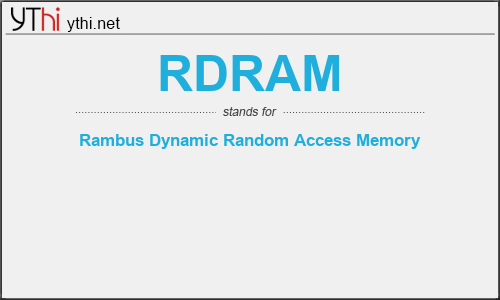What does RDRAM mean? What is the full form of RDRAM?
The full form of RDRAM is Rambus Dynamic Random Access Memory.
RDRAM (Rambus Dynamic Random Access Memory) is a memory subsystem that promises to transfer up to 1.6 billion bytes per second. The subsystem consists of the random access memory (RAM), the RAM controller, and the bus (path) connecting RAM to the microprocessor and devices in the computer that use it. Direct Rambus (DRDRAM), a technology developed and licensed by the Rambus Corporation, is the latest version and is expected to help accelerate the growth of visually intensive interfaces such as 3-D, interactive games, and streaming multimedia. Rambus is intended to replace the current main memory technology of dynamic random access memory (DRAM). Much faster data transfer rates from attached devices such as videocams using FireWire and the Accelerated Graphics Port (AGP) make it important to reduce the bottleneck in getting data into the computer, staging it in RAM, and moving it throught the microprocessor and to the display or other output devices.
RDRAM vs. DDR SDRAM
With the introduction of Intel Corp. chipsets in 2002 that supported double data rate SDRAM (DDR SDRAM) and RDRAM, the competing technologies both reached a data transfer bandwidth rate of 4,266 megabytes per second (MBps). RDRAM stayed competitive with DDR SDRAM through DDR 200 and DDR 300.
In 2003, Intel introduced a chipset that supported DDR 400 memory, which increased the data transfer bandwidth rate to 6,000 MBps. The terms DDR 200, DDR 300 and DDR 400 are clock-speed designations of the original DDR SDRAM memory technology (DDR1 SDRAM); the speed indicators were dropped with the introduction of DDR2 and beyond.
RDRAM effectively became obsolete with the launch of DDR 400, since it could no longer keep up in terms of data transfer speed or low latency rates. DDR SDRAM then became the de facto memory standard in most computing systems by the mid-2000s.
It’s used on Computing ,Hardware in Worldwide
RDRAM
means
Rambus Dynamic Random Access Memory![]()
Translate Rambus Dynamic Random Access Memory to other language.


Leave a Reply
You must be logged in to post a comment.